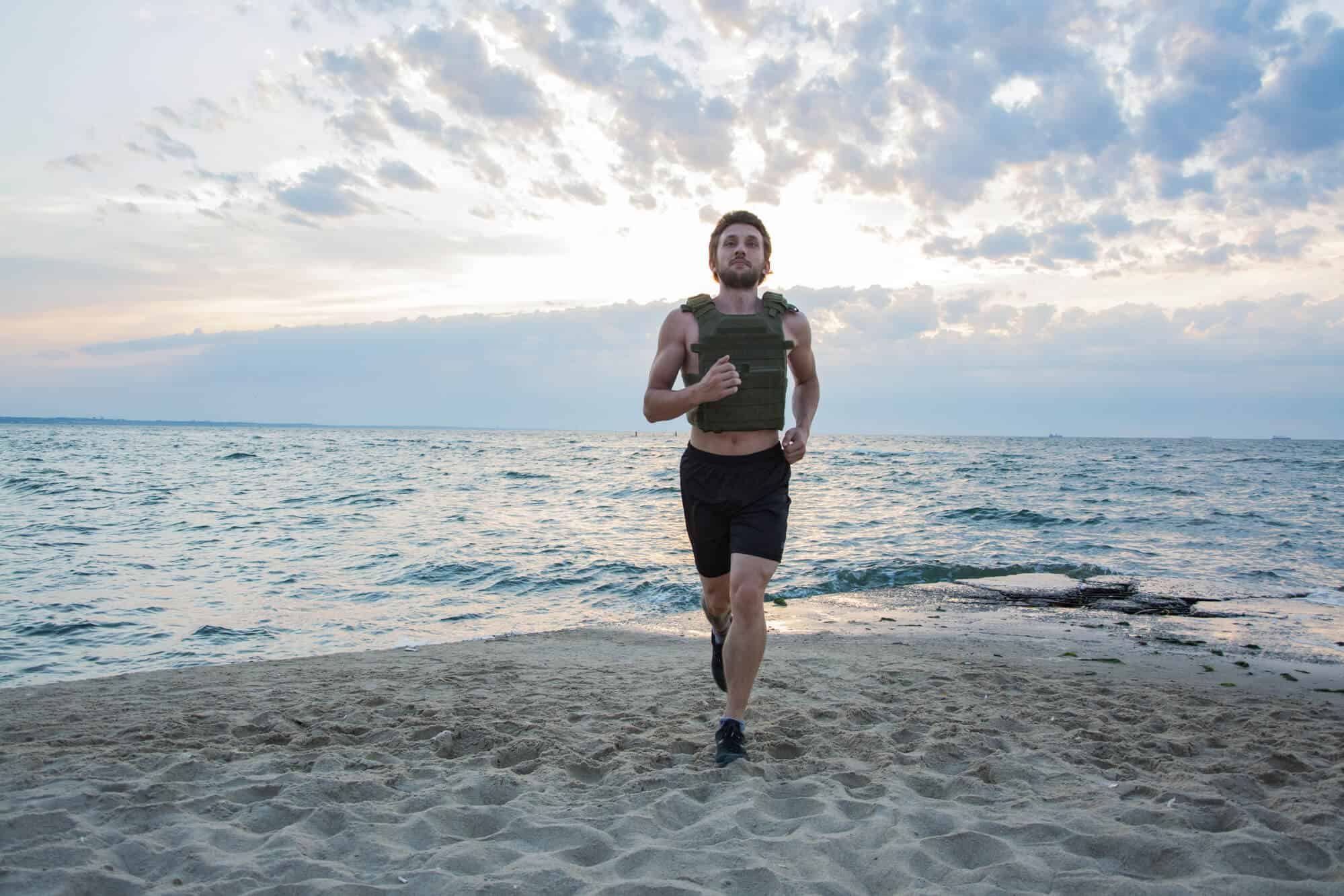Every day, there’s a new trend in the running community. At some point, smartwatches and water bottles that could monitor your consumption were all the hype. Now, runners are looking for new ways to improve their speed and push them further.
The latest trend is running with a weighted vest. Apparently, wearing one of these vests while running is enough to make you faster and lighter on your feet.
But is that true? Here’s everything you may need to know about running with a weight vest.
Running With Weighted Vests, Why Do Runners Use them?
Runners mostly use a weight vest when they want to up the intensity of their training. You probably already know that the more weight you carry, the harder you push your muscle mass and the more calories you burn.
And since carrying extra weight and running with it isn’t particularly easy, weighted vests provide a good alternative with their adjustable weight.
There are other benefits of Running With Weighted Vests, such as improving posture and increasing bone density. Aside from that, these vests make it easier for you to carry your phone and wallet while running. So, there are some non-physical benefits as well.
All in all, using a weight vest is merely one way to upgrade the way you train. It’s like running up a slope for a chance to challenge your muscles.
The Benefits of Running With Weighted Vests

For that many people to use weighted vests, they must pack some benefits, right?
Well, yes, weighted vests have a lot of benefits. Here’s a roundup.
Better Endurance
If you run the same distance with and without extra weight, you’ll notice the difference in your heartbeats. This is because the added weight puts more stress on your body. After all, it represents resistance.
For your body to overcome it, your lungs work harder, and your body’s ability to use oxygen becomes stronger—just like what happens when you do strength training.
As a result, you eventually improve your running time and endurance. Try taking the vest off, and you’ll find yourself running at a much faster speed than before.
So, weighted vests generally improve your endurance, allowing you to run for more time without feeling exhausted. You’ll also notice the effect when doing different exercises.
For example, you’ll find that you can sprint better and with less energy. Plus, any exercise that includes jumping will be easier to tackle when you’ve already built your endurance.
A Stronger Heart
Although you need more than just a weight vest to improve your cardio health, you can go a long way using it. When you run with the extra weight, your heart and lungs must work harder to deliver oxygen and blood.
As muscles work, when you push your heart harder, it develops a better pattern.
The effects of Running With Weighted Vest were explored in one study, and it turns out that most people who ran with weighted vests had surges in heart efficiency.
Challenging Your Skills
The thing with running is that it’s a repetitive sport. Unless you run some hills or increase the incline of your treadmill, you’ll keep doing pretty much the same. And unlike other sports, it’s hard to find different ways to run. The most you can do is vary the intensity and the time intervals of your training sessions.
And when you keep doing the same thing for a long time, your body eventually gets used to it, and it’s no longer challenging or hard to do.
With weighted vests, you get a chance to upgrade your training and challenge your skills. Let’s be honest; you won’t ever have an opportunity to run with extra weight unless you-god forbid-put on a lot of weight. So, weighted vests are good to switch your workouts and challenge your body.
Healthier Bones
When your bones carry a heavier load than they’re used to, they eventually grow stronger if you keep running long enough. As you probably already know, our bones strength gets affected with age, getting weaker and less dense.
So, when you train with weighted vests, you may delay this decline and keep your bones healthy for the longest duration possible. Not to mention, you may be able to protect yourself from osteoporosis, which is a common condition in older people.
Better Body Balance
There’s nothing to say that running with a weight vest will prevent you from falling. However, it may improve your body balance, help you run in a better posture, and decrease your chances of falling.
When you carry extra weight on your torso, you urge your back to stay straight to bear the weight. Even if you don’t notice it, your posture will be better balanced when running with a weighted vest.
Unfortunately, there’s not enough research on the matter, so you can grab your weighted vest and test the theory yourself.
The Disadvantages of Running With Weighted Vests
Like everything else, there are some disadvantages to using a weight vest. You’ll be putting more load on your body, and while that’s good for your health, it comes with some downsides. Here’s a roundup.
Back Problems

Weighted vests go around your torso, which is natural because no one will run with a weight attached to their thighs. However, that means that your back bears the weight rather than your lower body, which puts extra pressure on it. The same goes for your shoulders, which typically carry most of the weight.
If you’re prone to back problems, you’ll be risking vertebrae compression by wearing a weighted vest for running. These fellows also increase your chance of developing shoulder injuries.
The right way to go here is to use mild weights to test your body’s response. Then, increase the weight gradually and don’t cross your limits.
Injury Risk
While weighted vests are safe if you use them right, they still increase your risk of developing an injury. Aside from the pressure they put on your back and shoulders, they can cause you to lose your balance and fall.
If the weight shifts to one side amid running, your body will lose balance. You can easily avoid this by making sure to secure the weighted vest well around your abdomen and make sure the straps are tight enough.
Joint Pain

When your body puts on extra weight, more pressure is put on your joints to carry this weight. So, the joints in your knees, hips, and ankles will bear more weight. As a result, you may feel more pain when you start running with a weight vest.
The problem is avoidable by carrying reasonable weights and exercising your joints more to strengthen the muscles. However, a lot of people can expect to feel more pain when they start adding weight to their workout routine.
How to Practice Running With Weighted Vest
To practice running with a weighted vest, you first have to buy a vest and wear it for the first couple of times without filling it with weights. You need to get used to the idea of running with something around your torso before adding weight, so the first two times are for that.
Practice sprints with the weight vest on, and test the vest’s security around your body. If it doesn’t shift, and you are able to run well, you can start filling it with light weights.
Make sure the weight is distributed evenly and that the vest is secure around your torso to prevent it from shifting. Plus, for the first couple of times, keep the weight limited to three pounds or less until you get used to it.
How to Choose the Right Weighted Running Vest
To choose the right running vest, first, make sure it fits you right. it should be tight enough to stay around your torso without shifting, but it shouldn’t be compressing your body.
Additionally, you may want to choose a vest with shoulder pads, so you don’t feel pain with the additional weight. Lastly, try to look for a vest with adjustable straps, so you can adjust its fit around your body. An adjustable weighted vest is generally a good catch because you can use it for years even if your body’s shape changes.
Safety Precautions for Running With Weighted Vest
While weighted vests are packed with benefits, you have to be careful when using them, or else you’ll hurt your joints. Here are some safety precautions to follow:
- If you’re an osteoporosis patient, ask your doctor before using a weighted vest because you may unnecessarily load your bones.
- Load the weight to distribute it evenly, and make sure that it’s secured around your torso. If the weight vest shifts to one side while you’re running, you may fall.
- If it’s your first time using a weighted vest, it’s better to ask a doctor beforehand and run some checks to ensure your heart is healthy enough. The same goes for increasing the weight you’re carrying by a big difference.
- Try not to start with a heavyweight at once. Start with a little weight and go your way up.
- If you’re suffering an injury in any knee or ankle joints, don’t use a weight vest without consulting your doctor first. The same goes if you’re recovering from a strain, a stress fracture, or a pulled muscle.
Final Thoughts On Running With Weighted Vests
Amid all trends that spurt up in the running community, weighted vests are actually pretty beneficial.
They can help you take your running skills to a whole new level, and they’ll build you some good muscles.
Remember to follow the safety precautions when using a weight vest, and don’t add more than your body can handle.

